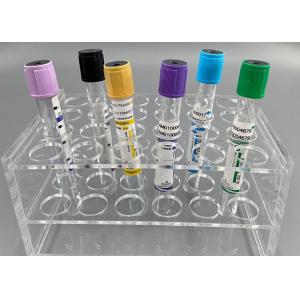
Add to Cart
Purple blood collection -- EDTA anticoagulant
It contains EDTA anticoagulant. Compared with other anticoagulants, EDTA anticoagulant has less effect on hemagglutination and morphology of blood cells, so EDTA salt (2k, 3k, 2Na) is usually used as anticoagulant. EDTA salt can combine with calcium ion in blood to form chelate, so as to prevent blood coagulation.
Sample type: whole blood, plasma
Application:
2ml: blood routine, reticulocyte, HBAIC, TC, BNP
5ml: pituitary, parathyroid hormone, renin, adrenal function, adrenocortical function, atch + COR, cortisol (COR), blood group + D antigen (syncytial blood)
It is not suitable for coagulation test and platelet function test, nor for determination of calcium, potassium, sodium, iron, alkaline phosphatase, creatine kinase, leucine aminopeptidase and PCR test.
The disposable vacuum blood collection container consists of a test tube, a plug, a cap, a label, additives (if any) and additives (if any).
Used in conjunction with disposable intravenous needles for the collection, transportation and preservation of human venous blood.
Store in a dry, well-ventilated and clean room with no corrosive gas and relative humidity above 80%
1.According to different test requirements, select the appropriate blood collection vessel. If you have any questions, please contact the staff of the laboratory at any time.
2.The sample number must be pasted on the blood collection vessel, which is consistent with the number on the inspection sheet. It should be pasted on the paper label of blood collection vessel, not on the glass to prevent falling off.
3. When taking blood, patients should be relaxed, warm environment, prevent venous contracture, tie tourniquet time should not be too long (now some scholars think that try not to use tourniquet), observe whether the blood collection is smooth, forbid to pat the arm, otherwise it may cause local blood concentration or activate the coagulation system.
4. The recommended order of blood collection is no anticoagulant tube (serum tube) → separation gel / accelerator tube → heparin / EDTA tube → coagulation vessel → blood sedimentation tube. The main reason is that the first tube often contains tissue fluid, which is easy to cause coagulation and is not suitable for hemagglutination test; Furthermore, to avoid the contamination of serum tube by anticoagulant.
5. After blood collection, the blood samples shall be rolled according to different test categories (biochemical, immune, routine, coagulation, ESR) with test sheets, and classified. All blood samples shall not be mixed together, so as to avoid confusion in operation.
6.The proportion of blood and anticoagulant must be accurate, and the blood volume should meet the requirements.
7 after blood collection, gently turn the test tube and mix 8-10 times, but do not vibrate violently. The sample should be placed vertically after blood collection.



